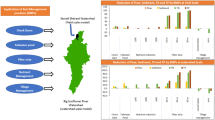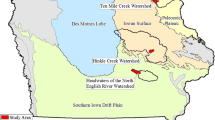Abstract
The study examined the influence of land-use (cropping patterns) and integrated agricultural best management practices (BMPs) on spring herbicide levels in an agricultural watershed. Atrazine and metolachlor were applied for weed control during spring of 1998–2002, 2005, and 2007–2013. Watershed-wide mass of applied herbicides ranged from 12.7 to 209.2 g atrazine and 10.9–302.2 g metolachlor with greatest application during 1998, 2009–2010 (atrazine) and 2007–2013 (metolachlor). Spring herbicide concentrations in Beasley Lake water ranged from below detection to 3.54 μg atrazine/L and 3.01 μg metolachlor/L. Multiple linear regression analyses with cropping patterns, BMPs, rainfall and time as independent variables, showed atrazine applications were associated with increases in cotton acreage and quail buffer, while metolachlor applications increased over time. Multiple linear regressions showed lake atrazine concentrations were associated with conservation tillage, rainfall, and corn, while lake metolachlor concentrations were associated with the cumulative metolachlor application and sediment retention pond installation.


Similar content being viewed by others
References
Alletto L, Coquet Y, Benoit P, Heddadj D, Barriuso E (2010) Tillage management on pesticide fate in soils. Agron Sustain Dev 30:367–400
Bouldin JL, Farris JL, Moore MT, Smith S, Cooper CM (2006) Hydroponic uptake of atrazine and lambda-cyhalothrin in Juncus effuses and Ludwigia peploides. Chemosphere 65:1049–1057
Brown TC, Froemke P (2012) Nationwide assessment of non-point source threats to water quality. Bioscience 62:136–146
Canadian Council of Ministers of the Environment (CCME) (1999a) Canadian water quality guidelines for the protection of aquatic life: Atrazine. In: Canadian environmental quality guidelines. Canadian Council of Ministers of the Environment, Winnipeg
Canadian Council of Ministers of the Environment (CCME) (1999b) Canadian water quality guidelines for the protection of aquatic life: Metolachlor. In: Canadian environmental quality guidelines. Canadian Council of Ministers of the Environment, Winnipeg
Conover WJ, Iman RL (1981) Rank transformations as a bridge between parametric and nonparametric statistics. Am Stat 35:124–129
Dunn AM, Julien R, Ernst WR, Cook A, Doe KG, Jackman PM (2011) Evaluation of buffer zone effectiveness in mitigating the risks associated with agricultural runoff in Prince Edward Island. Sci Total Environ 409:868–882
European Commission (2003) EU Pesticides database. ec.europa.eu/food/plant/pesticides/index-en.htm
EXTOXNET (Extension Toxicology Network) (1996a) Database: atrazine. Cornell University: Ithaca, NY. Accessed 11/22/2016 http://pmep.cce.cornell.edu/profiles/extoxnet/24d-captan/atrazine-ext.html
EXTOXNET (Extension Toxicology Network) (1996b) Database: metolachlor. Cornell University, Ithaca. http://pmep.cce.cornell.edu/profiles/extoxnet/metiram-propoxur/metolachlor-ext.html. Accessed 11/22/2016
Geier PW, Stahlman PW, Regehr DL, Olson BL (2009) Preemergence herbicide efficacy and phytotoxicity in grain sorghum. Weed Technol 23:197–201
Gourneau WS, Franti TG, Benham BL, Comfort SD (2001) Reducing long-term atrazine runoff from south central Nebraska. Trans ASAE 44:45–52
Harman WL, Wang E, Williams JR (2004) Reducing atrazine losses: Water quality implications of alternative runoff control practices. J Environ Qual 33:7–12
Krutz LJ, Senseman SA, Zablotowicz RM, Matocha MA (2005) Reducing herbicide runoff from agricultural fields with vegetative filter strips: A review. Weed Sci 53:353–367
Leu C, Singer H, Stamm C, Müller SR, Schwarzenbach RP (2004) Simultaneous assessment of sources, processes, and factors influencing herbicide losses to surface waters in a small agricultural catchment. Environ Sci Technol 38:3827–3834
Lizotte RE, Locke MA, Testa S (2014) Influence of varying nutrient and pesticide mixtures on abatement efficiency using a vegetated free water surface constructed wetland. Chem Ecol 30:280–294
Locke MA (2004) Mississippi delta management systems evaluation area: overview of water quality issues on a watershed scale. In: Nett MT, Locke MA, Pennington DA (eds) Water quality assessments in the Mississippi Delta: regional solutions, national scope. American Chemical Society, Washington DC, pp 1–15
Locke MA, Knight SS, Smith S, Cullum RF, Zablotowicz RM, Yuan Y, Bingner RL (2008) Environmental quality research in Beasley Lake watershed, 1995–2007: Succession from conventional to conservation practices. J Soil Water Conserv 63:430–442
Locke MA, Weaver MA, Zablotowicz RM, Steinriede RW, Bryson CT, Cullum RF (2011) Constructed wetlands as a component of the agricultural landscape: Mitigation of herbicides in simulated runoff from upland drainage areas. Chemosphere 83:1532–1538
Mickelson SK, Boyd P, Baker JL, Ahmed SI (2001) Tillage and herbicide incorporation effects on residue cover, runoff, erosion, and herbicide loss. Soil Till Res 60:55–66
Moore MT, Rodgers JH, Smith S, Cooper CM. (2001) Mitigation of metolachlor-associated agricultural runoff using constructed wetlands in Mississippi, USA. Agric Ecosyst Environ 84:169–176.
Murphy IJ, Coats JR (2011) The capacity of switchgrass (Panicum virgatum) to degrade atrazine in a phytoremediation setting. Environ Toxicol Chem 30:715–722
O’Donnell TK (2012) Assessing watershed transport of atrazine and nitrate to evaluate conservation practice effects and advise future monitoring strategies. Environ Manage 49:267–284
Pätzold S, Klein C, and Brümmer WG (2007) Run-off transport of herbicides during natural and simulated rainfall and its reduction by vegetated filter strips. Soil Use Manag 23:294–305
Pubchem (2016a) Chemistry database: atrazine. US National Library of Medicine, National Center for Biotechnology Information, Bethesda. https://pubchem.ncbi.nlm.nih.gov/compound/atrazine#section=Top. Accessed 11/22/2016
Pubchem (2016b) Chemistry database: metolachlor. US National Library of Medicine, National Center for Biotechnology Information, Bethesda. https://pubchem.ncbi.nlm.nih.gov/compound/metolachlor#section=Top. Accessed 11/22/2016
Rector RJ, Regehr DL, Barnes PL, Loughin TM (2003) Atrazine, S-metolachlor, and isoxaflutole loss in runoff as affected by rainfall and management. Weed Sci 51:810–816
Reichenberger S, Bach M, Skitschak A, Hans-Georg R (2007) Mitigation strategies to reduce pesticide inputs into ground- and surface water and their effectiveness: a review. Sci Total Environ 348:1–35
Riar DS, Norsworthy JK, Steckel LE, Stephenson DO, Eubank TW, Scott RC (2013) Assessment of weed management practices and problem weeds in the midsouth United States—soybean: a consultant’s perspective. Weed Technol 27:612–622
Senseman SA, Lavy TL, Mattice JD, Gbur EE, Skulman BW (1997) Trace level pesticide detections in Arkansas surface waters. Environ Sci Technol 31:395–401
Shaw DR, Schraer SM, Prince JM, Boyette M, Kingery WL (2006) Runoff losses of cyanazine and metolachlor: effects of soil type and precipitation timing. Weed Sci 54:800–806
Shipitalo MJ, Owens LB (2006) Tillage system, application rate, and extreme event effects on herbicide losses in surface runoff. J Environ Qual 35:2186–2194
Smith S, Cooper CM (2004) Pesticides in shallow ground water and lake water in the Mississippi Delta Management Systems Evaluation Area. In: Nett MT, Locke MA, Pennington DA (eds) Water quality assessments in the Mississippi Delta: regional solutions, national scope. American Chemical Society, Washington DC, pp 91–103
Tilman D, Balzer C, Hill J, Befort BL (2011) Global food demand and the sustainable intensification of agriculture. Proc Natl Acad Sci USA 108:20260–20264
Webster TM, Sosnoskie LM (2010) Loss of glyphosate efficacy: a changing weed spectrum in Georgia cotton. Weed Sci 58:73–79
Williams MM, Boydston RA, Peachey RE, Robinson D (2011) Performance consistency of reduced atrazine use in sweet corn. Field Crop Res 121:96–104
Author information
Authors and Affiliations
Corresponding author
Rights and permissions
About this article
Cite this article
Lizotte, R., Locke, M., Bingner, R. et al. Effectiveness of Integrated Best Management Practices on Mitigation of Atrazine and Metolachlor in an Agricultural Lake Watershed. Bull Environ Contam Toxicol 98, 447–453 (2017). https://doi.org/10.1007/s00128-016-2020-3
Received:
Accepted:
Published:
Issue Date:
DOI: https://doi.org/10.1007/s00128-016-2020-3




